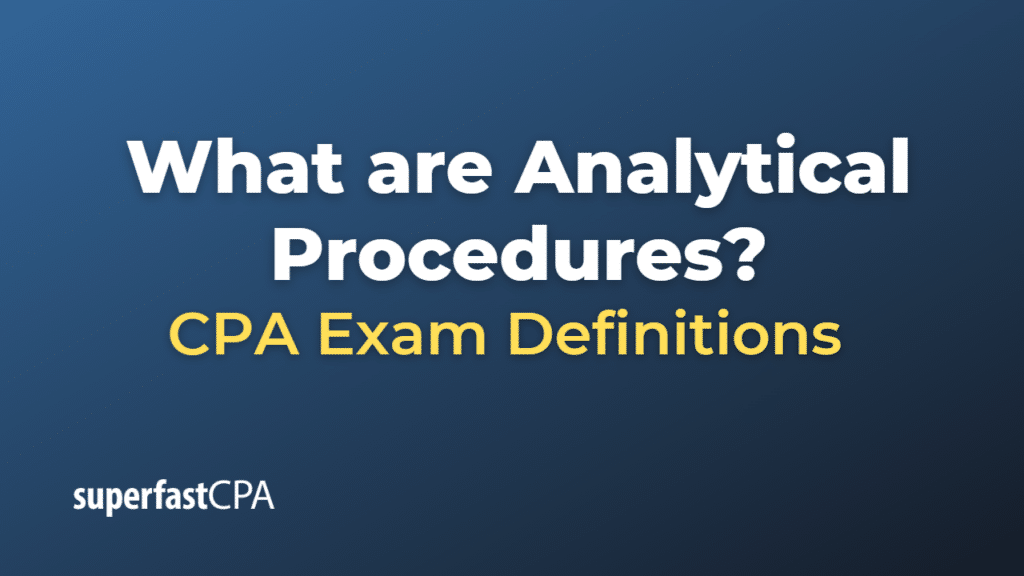Analytical Procedures
Analytical procedures are a set of evaluation techniques used by auditors, accountants, and financial analysts to assess the reasonableness of financial information, identify unusual patterns or inconsistencies, and form conclusions about a company’s financial condition. These procedures involve comparing recorded amounts or ratios to expectations based on relevant financial or non-financial data, industry trends, or the entity’s historical performance.
Analytical procedures are an essential part of the audit process, as they help auditors to gain a better understanding of the client’s business and identify potential risks that may require further investigation. Analytical procedures can be applied at different stages of an audit, including during the planning stage, substantive testing, and the final review.
Some common types of analytical procedures include:
- Trend analysis: Comparing the current year’s financial data with that of prior years to identify trends or significant changes in the company’s performance.
- Ratio analysis: Calculating financial ratios and comparing them to industry benchmarks or the company’s historical ratios to assess its liquidity, profitability, solvency, and efficiency.
- Reasonableness tests: Estimating an account balance or transaction amount based on relevant factors (e.g., sales volume, production capacity) and comparing the estimate to the recorded amount to determine if it is reasonable.
- Regression analysis: Using statistical techniques to analyze the relationship between financial and non-financial variables, which can help in identifying unusual patterns or predicting future performance.
The effectiveness of analytical procedures depends on the quality of the data used, the relevance of the relationships examined, and the auditor’s or analyst’s ability to form reasonable expectations. When unusual patterns or inconsistencies are identified through analytical procedures, further investigation may be necessary to determine the cause and assess the potential impact on the financial statements.
Example of Analytical Procedures
Let’s consider an example of using analytical procedures to review a company’s revenue.
Assume that ABC Corporation has been experiencing steady growth in recent years. An auditor is examining the company’s financial statements and wants to perform analytical procedures on the revenue account.
- Trend analysis: The auditor compares the current year’s revenue with the previous years’ revenue to analyze the growth pattern. If the company had revenue of $1 million, $1.2 million, and $1.4 million in the last three years, the auditor would expect a similar growth trend this year. If the current year’s revenue is significantly higher or lower than expected, it could indicate an issue that needs further investigation.
- Ratio analysis: The auditor calculates the gross profit margin (Gross Profit / Revenue) for the current year and compares it to the historical gross profit margin. If the margin has changed significantly, it might signal a change in the company’s pricing strategy, cost structure, or other factors affecting profitability.
- Reasonableness tests: The auditor may estimate the expected revenue based on external factors such as the industry’s growth rate, economic conditions, or competitor’s performance. For example, if the industry’s average growth rate is 10%, the auditor might expect ABC Corporation’s revenue to be around $1.54 million this year ($1.4 million * 1.1). A significant deviation from this expectation may warrant further investigation.
- Regression analysis: The auditor could use regression analysis to examine the relationship between revenue and a non-financial variable, such as the number of customers or website traffic. If the relationship is strong, any unusual variation in the revenue compared to the non-financial variable might indicate a potential issue.
By using these analytical procedures, the auditor can better understand ABC Corporation’s revenue patterns and identify any unusual trends or inconsistencies that may require further investigation. These techniques can provide valuable insights into the company’s financial performance and help assess the overall accuracy and reliability of the financial statements.













